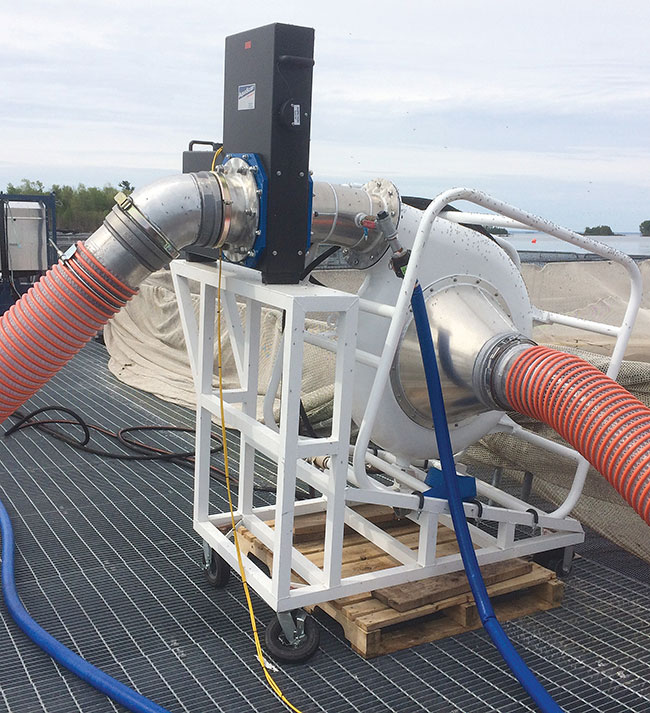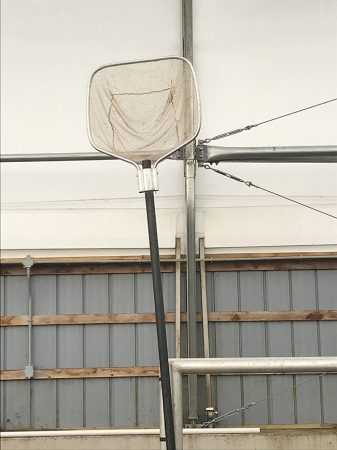
Features
Fish handling
Hatchery Operations
Fortune favours the prepared in successful and safe fish handling
July 22, 2022 By Ron Hill
 Photos: Ron Hill
Photos: Ron Hill Handling fish is a necessary evil at all fish sites. There is always the risk of disasters, small and large, such as dropped or damaged fish during the event. There is also higher-level risk created by increased stress from handling that can leave the stock vulnerable to pathogens. The fish must be handled, but proper handling is essential.
Preparation
A checklist should be run through setting up each phase of the operation to ensure the layout is correct, equipment is inspected and is in place, and that staff are properly assigned and trained to their task.
Starvation is a good place to start prep. Depending on the event, water temperature and the characteristics of the fish stock, a one to three-day starve will lower oxygen consumption and eliminate solid waste.
Oxygen monitoring is also key. In the crowder, in the anesthetic bath and in the recovery tote/tank are three key areas that must have a staff member assigned to watch the oxygen monitor. Areas where fish are concentrated, can deplete oxygen fast, especially if the fish react poorly to crowding. Have an oxygen strategy in place to deliver emergency oxygen quickly.
Crowding
Crowding can be a huge source of fish stress that often goes unnoticed. Using a divider to push fish into a dense crowd allows them to be captured by a net or pump easily but can have negative effects on the fish. Crowding must be done slowly to keep the fish crowded enough to allow capture, but not cause panic and stress.
Crowding the fish too much will cause collisions between fish and rubbing against the crowder, eroding slime and scales. Some fish will panic if they are aggressively crowded. Salmonids will “sound” when stressed – a school of overcrowded fish will suddenly release bubbles indicating their panic as they frantically swim into a dense ball or against the crowder. Don’t be afraid to back the crowder off if the fish are too dense.
Crowders are usually custom made for the farm and come in many shapes and sizes. The crowder should be looked over to make sure there is no damage that could hinder operations and also look for sharps that could scratch or damage fish.
Netting Fish
The time-honoured way of capturing fish is the trusty net. A great tool, so long as it is maintained and used properly. Dipping fish is a small art form that should be approached conservatively. Fish scoops should be gentle but firm and should keep the fish in the net for the shortest possible duration.
Avoid stabbing motions that strike the fish with the rim of the net. Use the tank walls to trap fish; use a partner for the “salad tong” method of bringing two nets together to trap fish. The biggest mistake made netting fish is too many fish in the net, causing fish on the bottom to be crushed.
To give some perspective, when a technician picks up a heavy net of fish, the weight of the net the tech is lifting is the same amount of weight pushing down on those fish at the bottom of the net. Nets should be inspected regularly for holes. Fish get stuck in net holes just like a commercial gill net. Holes are also a weak point that will continue to rip more as wear increases and can suddenly leave the technician with a net full of fish on the ground when the mesh lets go.
Pumping Fish
Pumping fish, though much less labour intensive, requires proper operation and care. Moving the fish in water, without netting, decreases potential stress on the fish. Crowding becomes very important for pumping fish because the crowder controls the flow of fish into the pump.
Too many fish being pumped at once, too many fish in the line, causes collisions and friction throughout the trip. These crowded fish in the line deplete oxygen quickly as well. Fish moving through a fish pump tend to be moving fast which means there must be something to slow them down as they leave the hose, such as flaps, a deep-water bath, or a pad–solutions vary- to prevent high speed collisions with solid objects such as tank walls.

Photos: Ron Hill
Anesthetizing Fish
Anesthetizing fish properly with the right amount of anesthetic and monitoring their “sleepiness” is as essential as safe handling. Care must be taken to let the fish reach full anesthetization before handling. Care must also be taken to anesthetize only enough fish in a batch that can be handled before they overcome the anesthetic.
Fish in the anesthetic must also be carefully watched to make sure none stay in the anesthetic too long or are lost in the bath when new fish are added. Awake or half-awake fish are both a fish health and human health risk, especially during delicate handling events like tagging or vaccination.
Handling Tasks
Whether it be vaccination, measurements, tagging, ripeness checks, etc., there are many handling tasks that would require a fish handling event. Each facility should develop SOPs with best practices for each particular task. Whatever the task, technicians should follow these principles to ensure the best for the fish:
- Keep the fish in water as much as possible.
- Handle the fish as gently and as little as possible.
- Work as quick as accuracy/safety allows.
- Combine as many handling tasks as feasible/safe to one handling event.
- Put the fish into recovery as soon as possible.
Return and Recovery
Return and recovery seems like the end of the line, past the crucial point of the handling event, where fish are cruising safely home. However, without a proper return and recovery system anesthetized fish are still at risk.
Fish return should be gentle and strategic as the fish are probably not awake and will not be able to swim or gain their equilibrium for some time. Return lines, or return nets, buckets, etc. should be setup to put the fish into a safe place in the tank for them to recover.
Fish should drop into the tank at a shallow angle to avoid hard impacts with the tank bottom and away from the tank wall to avoid impacts there. Ideally, fish should drop away from the centre screen so they are not sucked to the screen and scratched or damaged before they can swim away.
In some situations, a separate recovery tote or tank can be a benefit before adding fish back to the population. Recovery tarps, placed like a small shelf or cradle 12 inches underwater in the tank, can be a safe place for fish to recover, allowing them to rejoin the population when they can swim again.
Fish handling success is achievable with very low mortality if the farmer puts together a good plan and puts fish health and safety first.
Print this page
Advertisement
- Acoustics as non-invasive technique to monitor swimbladder inflation and larval growth in seabream (Sparus aurata)
- Russia sees progress in genome sequencing program





